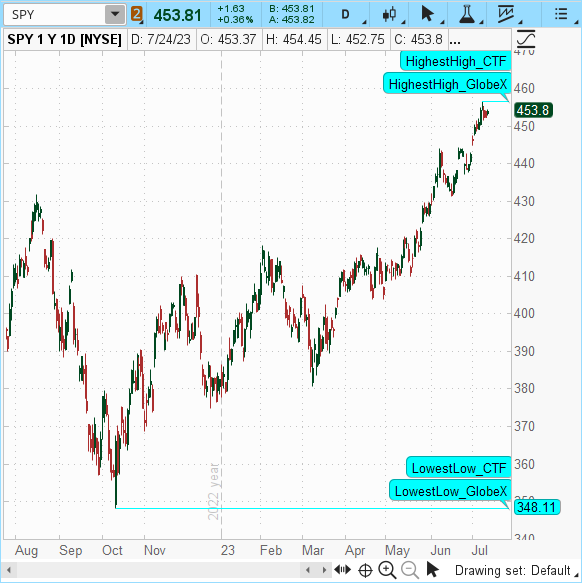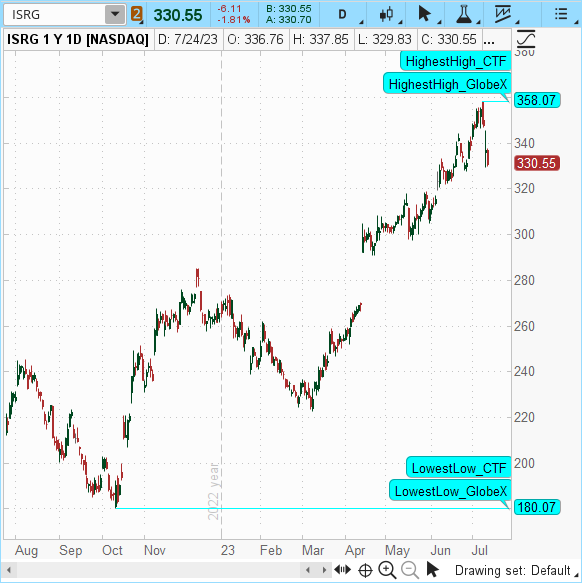## OneNote Archive Name: WIP_PickAPlotPlus_v03
## Suggested Tos Name using JQ naming convention: WIP_PickAPlotPlus_v03
## OneNote Section: Support Resistance
## Archive Date:
## Provenance: scripted and archived by JQ
## Archive, Usage or Lounge Notes:
# Concept by JQ
# Initialization and vastly superior logic by Nube...thank you!
## Drafting Notes:
# 02.26.2019 Begin drafting
## End OneNote Archive Header
declare upper;
# Universal Definitions using Padawan variable naming convention (JQ) v03.04.2019
# iData Definitions
def vHigh = high; # creates the variable vHigh. Use of the variable reduce data calls to tos iData server
def initHigh = CompoundValue(1, high, high); # creates and initialized variable for High
def vLow = low;
def initLow = CompoundValue(1, low, low);
def vOpen = open;
def initOpen = CompoundValue(1, open, open);
def vClose = close;
def initClose = CompoundValue(1, close, close);
def vVolume = volume;
def initVolume = CompoundValue(1, volume, volume);
def nan = Double.NaN;
# Bar Definitions (Time & Date)
def bn = BarNumber();
def currentBar = HighestAll(if !IsNaN(vHigh) then bn else nan);
def Today = GetDay() ==GetLastDay();
def time = GetTime();
def GlobeX = GetTime() < RegularTradingStart(GetYYYYMMDD());
# def globeX_v2 = if time crosses below RegularTradingEnd(GetYYYYMMDD()) then bn else GlobeX[1];
def RTS = RegularTradingStart(GetYYYYMMDD());
def RTE = RegularTradingEnd(GetYYYYMMDD());
def RTH = GetTime() > RegularTradingStart(GetYYYYMMDD());
def RTH_v2 = if time crosses above RegularTradingStart(GetYYYYMMDD()) then bn else RTH[1];
# Bubble Locations
def x_AxisLastExpansionBar = BarNumber() == HighestAll(BarNumber()); #corrected 11.12.2018 (JQ)
# syntax: addChartBubble(x_AxisLastExpansionBar, y-axis coordinate," text", Color.LIME); #verified 12.25.2018 (JQ)
## Begin Globex Code
## Globex Highest High Code
## Inputs
input HighestHighGlobeX = {"Do Not Display", "From High to Current Bar", default "From High into Expansion Area", "Entire Chart Time Frame"};
#input "Highest High Test" = "the manual states this should function properly";
#addlabel(1,"Highest High Test",color.white);
## Definitions (specific to Globex script)
def iterHighestPrice_GlobeX = if GlobeX and !GlobeX[1]
then initHigh
else if GlobeX and initHigh > iterHighestPrice_GlobeX[1]
then initHigh
else iterHighestPrice_GlobeX[1];
## Iteratively discover the Highest Price occurring during the desired time period
def iterHighestBar_GlobeX = if GlobeX and initHigh == iterHighestPrice_GlobeX
then bn
else Double.NaN;
## Iteratively discover the bar at which the Highest Price occurs
def HighestHigh_GlobeX = if BarNumber() == HighestAll(iterHighestBar_GlobeX)
then iterHighestPrice_GlobeX
else HighestHigh_GlobeX[1];
## define a variable which is assigned a value equal to the Highest High
## beginning with the bar at which the highest high occurs and then
## assign that value (highest high) to any future bars
## Switch Code
plot HighestHigh_GlobeX_plot;
HighestHigh_GlobeX_plot.SetDefaultColor(Color.CYAN);
switch (HighestHighGlobeX)
{
case "Do Not Display":
HighestHigh_GlobeX_plot = nan;
case "From High to Current Bar":
HighestHigh_GlobeX_plot =
if Between(bn, HighestAll(iterHighestBar_GlobeX), currentBar)
then HighestHigh_GlobeX
else nan;
case "From High into Expansion Area":
HighestHigh_GlobeX_plot =
if bn >= HighestAll(iterHighestBar_GlobeX)
then HighestHigh_GlobeX
else nan;
case "Entire Chart Time Frame":
HighestHigh_GlobeX_plot =
HighestAll(HighestHigh_Globex);
}
## End Switch Code
## addChartBubble Code
input showGlobeX_HHighBubble = yes;
AddChartBubble(x_AxisLastExpansionBar and showGlobeX_HHighBubble, HighestHigh_GlobeX_plot, "HighestHigh_GlobeX", HighestHigh_GlobeX_plot.TakeValueColor());
## End GlobeX Highest High Code
## ----- ----- ----- ----- ----- ----- ----- -----
## Begin GlobeX Lowest Low Code
## Inputs
input LowestLowGlobeX = {"Do Not Display", "From Low to Current Bar", default "From Low into Expansion Area", "Entire Chart Time Frame"};
## Definitions
def iterLowestPrice_GlobeX = if GlobeX and !GlobeX[1] or bn == 1
then initLow
else if GlobeX and initLow < iterLowestPrice_GlobeX[1]
then initLow
else iterLowestPrice_GlobeX[1];
def iterLowestBar_GlobeX = if GlobeX and vLow == iterLowestPrice_GlobeX
then bn
else Double.NaN;
def LowestLow_GlobeX = if BarNumber() == HighestAll(iterLowestBar_GlobeX)
then iterLowestPrice_GlobeX
else LowestLow_GlobeX[1];
## Switch Code
plot LowestLow_GlobeX_plot;
LowestLow_GlobeX_plot.SetDefaultColor(Color.CYAN);
switch (LowestLowGlobeX)
{
case "Do Not Display":
LowestLow_GlobeX_plot = nan;
case "From Low to Current Bar":
LowestLow_GlobeX_plot =
if Between(bn, HighestAll(iterLowestBar_GlobeX), currentBar)
then LowestLow_GlobeX
else nan;
case "From Low into Expansion Area":
LowestLow_GlobeX_plot =
if bn >= HighestAll(iterLowestBar_GlobeX)
then LowestLow_GlobeX
else nan;
case "Entire Chart Time Frame":
LowestLow_GlobeX_plot =
HighestAll(LowestLow_GlobeX);
}
## End Switch Code
## addChartBubble Code
input showGlobeX_LLowBubble = yes;
AddChartBubble(x_AxisLastExpansionBar and showGlobeX_LLowBubble, LowestLow_GlobeX_plot, "LowestLow_GlobeX", LowestLow_GlobeX_plot.TakeValueColor());
## End GlobeX Lowest Low Code
## End GlobeX Code
## === === === === === === === === === === === === === === === ===
## Begin RTH Code
## Begin RTH Highest High Code
## Inputs
input HighestHighRTH = {"Do Not Display", "From High to Current Bar", default "From High into Expansion Area", "Entire Chart Time Frame"};
## Definitions (specific to this script)
## def RTH = GetTime() > RegularTradingStart(GetYYYYMMDD());
## def RTH_v2 = if time crosses above RegularTradingStart(GetYYYYMMDD()) then bn else RTH[1];
def iterHighestPrice_RTH = if RTH and !RTH[1]
then initHigh
else if RTH and initHigh > iterHighestPrice_RTH[1]
then initHigh
else iterHighestPrice_RTH[1];
## Iteratively discover the Highest Price occurring during the desired time period
def iterHighestBar_RTH = if RTH and initHigh == iterHighestPrice_RTH
then bn
else Double.NaN;
## Iteratively discover the bar at which the Highest Price occurrs
def HighestHigh_RTH = if BarNumber() == HighestAll(iterHighestBar_RTH)
then iterHighestPrice_RTH
else HighestHigh_RTH[1];
## define a variable which is assigned a value equal to the Highest High
## beginning with the bar at which the highest high occurs and then
## assign that value (highest high) to any future bars
## Switch Code
plot HighestHigh_RTH_plot;
HighestHigh_RTH_plot.SetDefaultColor(Color.CYAN);
switch (HighestHighRTH)
{
case "Do Not Display":
HighestHigh_RTH_plot = nan;
case "From High to Current Bar":
HighestHigh_RTH_plot =
if Between(bn, HighestAll(iterHighestBar_RTH), currentBar)
then HighestHigh_RTH
else nan;
case "From High into Expansion Area":
HighestHigh_RTH_plot =
if bn >= HighestAll(iterHighestBar_RTH)
then HighestHigh_RTH
else nan;
case "Entire Chart Time Frame":
HighestHigh_RTH_plot =
HighestAll(HighestHigh_RTH);
}
## End Switch Code
## addChartBubble Code
input showRTH_HHighBubble = yes;
AddChartBubble(x_AxisLastExpansionBar and showRTH_HHighBubble, HighestHigh_RTH_plot, "HighestHigh_RTH", HighestHigh_RTH_plot.TakeValueColor());
## End RTH Highest High Code
## Begin RTH Lowest Low Code
## Inputs
input LowestLowRTH = {"Do Not Display", "From High to Current Bar", default "From High into Expansion Area", "Entire Chart Time Frame"};
## Definitions
def iterLowestPrice_RTH = if RTH and !RTH[1]
then initLow
else if RTH and initLow < iterLowestPrice_RTH[1]
then initLow
else iterLowestPrice_RTH[1];
def iterLowestBar_RTH = if RTH and initLow == iterLowestPrice_RTH
then bn
else Double.NaN;
def LowestLow_RTH = if BarNumber() == HighestAll(iterLowestBar_RTH)
then iterLowestPrice_RTH
else LowestLow_RTH[1];
## Switch Code
plot LowestLow_RTH_plot;
LowestLow_RTH_plot.SetDefaultColor(Color.CYAN);
switch (LowestLowRTH)
{
case "Do Not Display":
LowestLow_RTH_plot = nan;
case "From High to Current Bar":
LowestLow_RTH_plot =
if Between(bn, HighestAll(iterLowestBar_RTH), currentBar)
then LowestLow_RTH
else nan;
case "From High into Expansion Area":
LowestLow_RTH_plot =
if bn >= HighestAll(iterLowestBar_RTH)
then LowestLow_RTH
else nan;
case "Entire Chart Time Frame":
LowestLow_RTH_plot =
HighestAll(LowestLow_RTH);
}
## End Switch Code
## addChartBubble Code
input showRTH_LLowBubble = yes;
AddChartBubble(x_AxisLastExpansionBar and showRTH_LLowBubble, LowestLow_RTH_plot, "LowestLow_RTH", LowestLow_RTH_plot.TakeValueColor());
## End RTH Lowest Low Code
## End RTH Code
## === === === === === === === === === === === === === === === ===
## Begin CTF Code
## Begin CTF Highest High Code
## Begin Highest High Chart Time Frame
## Inputs
input HighestHighCTF = {"Do Not Display", "From High to Current Bar", default "From High into Expansion Area", "Entire Chart Time Frame"};
## Definitions (specific to this script)
def iterHighestPrice_CTF = HighestAll(vHigh); # Highest High Price for the Chart Time Frame
def HighestHighBar_CTF = HighestAll(if vHigh == HighestAll(vHigh) then bn else nan);
## Switch Code
plot HighestHigh_CTF_plot;
HighestHigh_CTF_plot.setDefaultColor(color.CYAN);
switch (HighestHighCTF)
{
Case "Do Not Display":
HighestHigh_CTF_plot = nan;
Case "From High to Current Bar":
HighestHigh_CTF_plot = if Between(bn, HighestHighBar_CTF, currentBar) then iterHighestPrice_CTF else nan;
Case "From High into Expansion Area":
HighestHigh_CTF_plot = if bn >= HighestHighBar_CTF then iterHighestPrice_CTF else nan;
Case "Entire Chart Time Frame":
HighestHigh_CTF_plot = iterHighestPrice_CTF;
}
## End Switch Code
## addChartBubble Code
input showCTF_HHighBubble = yes;
AddChartBubble(x_AxisLastExpansionBar and showCTF_HHighBubble, HighestHigh_CTF_plot, "HighestHigh_CTF", HighestHigh_CTF_plot.TakeValueColor());
## End CTF Highest High Code
## Begin CTF Lowest Low Code
## Inputs
input LowestLowCTF = {"Do Not Display", "From Low to Current Bar", default "From Low into Expansion Area", "Across Entire Chart"};
## Definitions (specific to this script)
def iterLowestPrice_CTF = LowestAll(vLow);
def iterLowestBar_CTF = HighestAll(if vLow == LowestAll(vLow) then bn else nan);
## Switch Code
plot LowestLow_CTF_plot;
LowestLow_CTF_plot.setDefaultColor(color.CYAN);
switch (LowestLowCTF)
{
Case "Do Not Display":
LowestLow_CTF_plot = nan;
Case "From Low to Current Bar":
LowestLow_CTF_plot = if Between(bn, iterLowestBar_CTF, currentBar) then iterLowestPrice_CTF else nan;
Case "From Low into Expansion Area":
LowestLow_CTF_plot = if bn >= iterLowestBar_CTF then iterLowestPrice_CTF else nan;
Case "Across Entire Chart":
LowestLow_CTF_plot = iterLowestPrice_CTF;
}
## End Switch Code
## addChartBubble Code
input showCTF_LLowBubble = yes;
AddChartBubble(x_AxisLastExpansionBar and showCTF_LLowBubble, LowestLow_CTF_plot, "LowestLow_CTF", LowestLow_CTF_plot.TakeValueColor());
## End CTF Lowest Low Code
## End CTF Code
## End WIP_PickAPlotPlus_v0


